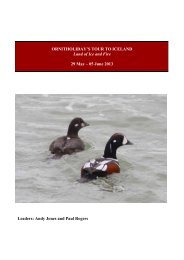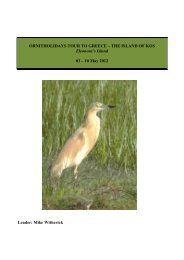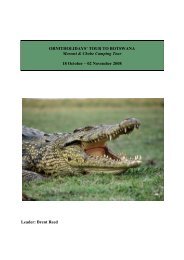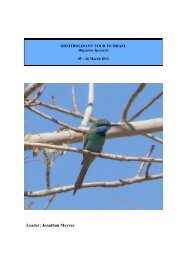Download 2014 Brochure (.pdf) - Ornitholidays
Download 2014 Brochure (.pdf) - Ornitholidays
Download 2014 Brochure (.pdf) - Ornitholidays
You also want an ePaper? Increase the reach of your titles
YUMPU automatically turns print PDFs into web optimized ePapers that Google loves.
European Roller<br />
P O R T U G A L<br />
Salon View, Quinta do Barranco<br />
keeping an eye on the sea for passing gulls and<br />
terns, as well as watching aerobatic Pallid Swifts.<br />
Suitably refreshed we will drive down to the<br />
Cabo de Sao Vicente. Besides admiring the<br />
scenery, we will look for Red-billed Chough,<br />
Tawny Pipit and perhaps some late migrants<br />
using this location as a stepping stone in their<br />
northward journey from Africa. During the<br />
remainder of the afternoon we will visit two<br />
lagoonal areas along the south coast. Hopefully,<br />
they will offer us a range of waders and water<br />
birds, and some of the local specialities such as<br />
Purple Swamphen, Little Bittern, Black-winged<br />
Stilt and Little Tern.<br />
A second day tour will involve travelling northwest<br />
to the coast at Santo Andre. Here we will explore<br />
the Lagoa Santo Andre and extend our list of<br />
waders and water birds. We would hope to find<br />
Purple Heron, Eurasian Spoonbill and Redcrested<br />
Pochard, as well as Western Marsh<br />
Harrier. The fringing vegetation holds Great Reed<br />
and Savi’s Warblers as well as Zitting Cisticola. If<br />
the water level is good, we will spend much of the<br />
day exploring the shores of the lagoon and its<br />
adjacent woodlands and meadows. Failing this,<br />
we will drive further northwards to the south side<br />
of the estuary of the Sado River where, in addition<br />
to marshes and mudflats, there are rice-fields,<br />
which hold flocks of Common Waxbill. The return<br />
journey from both locations will take us through<br />
areas of open cork oak woodland, a habitat<br />
favoured by Black-winged Kite. Other raptors we<br />
would hope to see during the day include Booted<br />
and Short-toed Eagles and Black Kite.<br />
The third excursion will involve exploring the rolling<br />
plains of Alentejo that lie to the east. These hold<br />
good numbers of Great and Little Bustards. Other<br />
notable species include Black-bellied Sandgrouse,<br />
Stone Curlew, Iberian Grey Shrike, Montagu’s<br />
Harrier, Lesser Kestrel and Little Owl. Five species<br />
of lark – Calandra, Crested, Thekla, Short-toed and<br />
Wood – can be observed, whilst at the many<br />
ponds that dot the landscape, we may find<br />
Collared Pratincole, Little Ringed Plover and Gullbilled<br />
Tern. As we make our way along the<br />
traffic-free roads, we will see that most poles,<br />
masts and chimneys are crowned by White Storks<br />
nests with Spanish Sparrows often sharing the<br />
accommodation.<br />
The three half day excursions will involve some<br />
gentle walks only a short drive from the lodge.<br />
They will be much more relaxing than the full days<br />
and give us the opportunity to pay more attention<br />
to the wild flowers, butterflies and dragonflies we<br />
encounter. Clear water streams trickle along valley<br />
floors inhabited by noisy Iberian and Edible Frogs<br />
and dragonflies such as Blue Emperor and<br />
Western Clubtail. The streamside meadows are a<br />
riot of colour dominated by French Lavender,<br />
Viper's Bugloss and several Cistus species. The<br />
abundance of flowers acts as a magnet to a<br />
variety of butterflies, including Spanish Marbled<br />
White, Spanish Fritillary, Spanish Gatekeeper,<br />
Long-tailed Blue, Cleopatra and the striking Twotailed<br />
Pasha. Recent tours have had the good<br />
fortune to see the rare Monarch Butterfly, perhaps<br />
individuals from colonies now established in The<br />
Azores and on the Canary Islands.<br />
The valley slopes are dotted with ancient Cork<br />
Oaks and stands of the recently introduced<br />
Eucalyptus trees, the latter often favoured by<br />
Golden Orioles. Birds include Common<br />
Nightingale, Eurasian Hoopoe, Common<br />
Cuckoo, Rock, Cirl and Corn Buntings,<br />
Woodchat Shrike, Azure-winged Magpie,<br />
Spotless Starlings, Cetti's and Melodious<br />
Warblers and Iberian Chiffchaff. Perhaps the<br />
most notable feature of these excursions is the<br />
opportunity to walk in an unspoilt rural<br />
landscape where the hum of bees replaces the<br />
drone of traffic.<br />
After lunch at the Quinta there is the opportunity to<br />
relax with time to explore the walks around the<br />
lakes, to catch up on diaries, write postcards or<br />
read.<br />
Day 8<br />
After breakfast we will depart for Faro where we<br />
catch our return flight to London or regional<br />
airports.<br />
Outline Itinerary<br />
Day 1 Fly to Faro and transfer<br />
to Santa Clara<br />
Days 2-7 Santa Clara<br />
Day 8 Depart Faro<br />
Party size<br />
Maximum of 13 clients (two leaders with<br />
more than seven clients).<br />
Accommodation<br />
Comfortable accommodation in twin/double<br />
and single rooms, with private facilities.<br />
Transport<br />
By minibuses driven by leaders.<br />
Includes<br />
All flights, meals, accommodation, transport,<br />
services of leaders, VAT, airport taxes and tips.<br />
Gradings<br />
Good<br />
120<br />
Warm<br />
Low<br />
Normal<br />
Relaxed<br />
Good<br />
Easy<br />
Scheduled<br />
Black-winged Stilts<br />
To make a booking please call <strong>Ornitholidays</strong> on 01794 519445<br />
117








